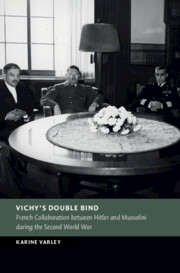Refine search
Actions for selected content:
15401 results in Military history
Part II - Local Encounters
-
- Book:
- Vichy's Double Bind
- Published online:
- 18 May 2023
- Print publication:
- 01 June 2023, pp 117-194
-
- Chapter
- Export citation
Introduction
-
- Book:
- Vichy's Double Bind
- Published online:
- 18 May 2023
- Print publication:
- 01 June 2023, pp 1-12
-
- Chapter
- Export citation
Index
-
- Book:
- Peacemaking and International Order after the First World War
- Published online:
- 18 May 2023
- Print publication:
- 01 June 2023, pp 415-428
-
- Chapter
- Export citation
Contributors
-
- Book:
- Peacemaking and International Order after the First World War
- Published online:
- 18 May 2023
- Print publication:
- 01 June 2023, pp vii-viii
-
- Chapter
- Export citation
Acknowledgements
-
- Book:
- Vichy's Double Bind
- Published online:
- 18 May 2023
- Print publication:
- 01 June 2023, pp vii-viii
-
- Chapter
- Export citation
8 - The League of Nations
- from Part II - Institutions
-
-
- Book:
- Peacemaking and International Order after the First World War
- Published online:
- 18 May 2023
- Print publication:
- 01 June 2023, pp 202-226
-
- Chapter
- Export citation
6 - The Challenge of an Absent Peace in the French and British Empires after 1919
- from Part I - Ordering Concepts
-
-
- Book:
- Peacemaking and International Order after the First World War
- Published online:
- 18 May 2023
- Print publication:
- 01 June 2023, pp 151-176
-
- Chapter
- Export citation
15 - Colonial Nationalists and the Making of a New International Order
- from Part III - Actors and Networks
-
-
- Book:
- Peacemaking and International Order after the First World War
- Published online:
- 18 May 2023
- Print publication:
- 01 June 2023, pp 361-378
-
- Chapter
- Export citation
Contents
-
- Book:
- Vichy's Double Bind
- Published online:
- 18 May 2023
- Print publication:
- 01 June 2023, pp v-vi
-
- Chapter
- Export citation
Copyright page
-
- Book:
- Vichy's Double Bind
- Published online:
- 18 May 2023
- Print publication:
- 01 June 2023, pp iv-iv
-
- Chapter
- Export citation

Peacemaking and International Order after the First World War
-
- Published online:
- 18 May 2023
- Print publication:
- 01 June 2023

Vichy's Double Bind
- French Collaboration between Hitler and Mussolini during the Second World War
-
- Published online:
- 18 May 2023
- Print publication:
- 01 June 2023
Preface
-
- Book:
- Between God and Hitler
- Published online:
- 14 April 2023
- Print publication:
- 11 May 2023, pp ix-xiii
-
- Chapter
- Export citation
Copyright page
-
- Book:
- Between God and Hitler
- Published online:
- 14 April 2023
- Print publication:
- 11 May 2023, pp iv-iv
-
- Chapter
- Export citation
4 - Saving Christianity, Killing Jews
-
- Book:
- Between God and Hitler
- Published online:
- 14 April 2023
- Print publication:
- 11 May 2023, pp 113-146
-
- Chapter
- Export citation
1 - “We Will Not Let Our Swords Get Rusty”
-
- Book:
- Between God and Hitler
- Published online:
- 14 April 2023
- Print publication:
- 11 May 2023, pp 22-43
-
- Chapter
- Export citation
Abbreviations
-
- Book:
- Between God and Hitler
- Published online:
- 14 April 2023
- Print publication:
- 11 May 2023, pp xix-xx
-
- Chapter
- Export citation
Figures
-
- Book:
- Between God and Hitler
- Published online:
- 14 April 2023
- Print publication:
- 11 May 2023, pp vi-vii
-
- Chapter
- Export citation
2 - “In Times of Peace the Church Arms Herself for War”
-
- Book:
- Between God and Hitler
- Published online:
- 14 April 2023
- Print publication:
- 11 May 2023, pp 44-77
-
- Chapter
- Export citation
Bibliography
-
- Book:
- Between God and Hitler
- Published online:
- 14 April 2023
- Print publication:
- 11 May 2023, pp 283-312
-
- Chapter
- Export citation
